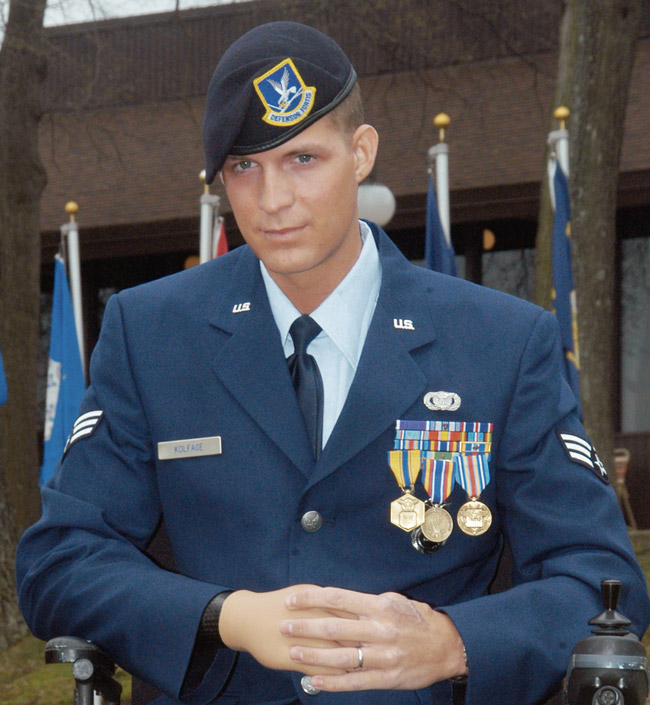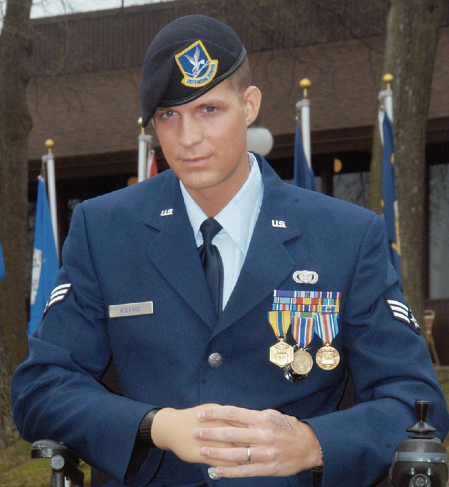Back On His Feet After Losing His Legs
Kaimuki High grad Brian Kolfage brings a message of determination and hope to a Navy League audience
Brian Kolfage says he was nothing special, just an ordinary airman.
If that’s the case, the Air Force recruiters are doing one hell of a good job. Kolfage, a Kaimuki High School graduate, returned to Hawaii to speak at Navy League-Honolulu’s annual Sea Service Awards luncheon. The ceremony is typically highlighted by inspiring individuals chosen for their accomplishments or inspirational stories. None better fit than the medically retired airman.
Kolfage is a triple amputee whose legs were “liquified” – as he describes it – when he was struck by a 107 mm rocket while deployed to Iraq. That he survived was impressive enough. That he is the first person to walk after suffering his level of amputation, and that he did so with the same determination and carefree attitude he showed surfing in Hawaii and playing hockey in Michigan, is what makes his story particularly remarkable.
In 2004, Kolfage was stationed in Kuwait during his second deployment in as many years when the call went out for 13 servicemembers to transfer to Iraq’s deadly Sunni Triangle. Bored with his current assignment, he volunteered.
“There is nothing going on in Kuwait. It was like an ordinary 9-to-5 job doing something stupid like inspecting stuff and security, but there is nothing going on. It’s like America,” says Kolfage with a mixture of comedy and matter-of-fact calm that seems to identify him.
In Iraq, however, enemy attacks against the base were almost daily occurrences. At times, some 15 rockets and other deadly devices would be launched into the base, which was located in Saddam Hussein’s stronghold. “We used to get shelled all the time. It was no big deal.”
Mostly, the projectiles fell harmlessly away from their human targets, but on Sept. 11, 2004, the rockets found their mark. Had he not been just minutes from medical attention and if not for the quick actions of his comrades, the outcome could have been much different.
“If I was off base I’d be dead,” he says. “That’s why most people don’t survive these injuries.”
The explosion threw Kolfage against a wall 20 feet from where he’d just been standing. His mouth and ears were full of sand but he felt no pain, at least not immediately. In fact, he thought he was hallucinating, a common side effect of the anti-malaria medication he was taking.
Then reality set in.
“It was the worst pain I ever felt,” he says. “I thought my body had been split in half.”
It basically had been. “I remember being on my back and seeing the American flag and all the doctors were around me. The look on their face was horrified.”
Photos of the damage taken by doctors moments after the attack showed the gruesome details. What had been Kolfage’s legs were two massive open wounds, which resulted in so much blood loss that even after the first successful surgery, the prognosis wasn’t good. A chaplain was sent to his parents’ home where they were told to make immediate plans to fly to Walter Reed Medical Center in Washington, D.C., most likely to say goodbye to their 22-year-old son. After being stabilized, he was flown to Walter Reed, where he was put into a medically induced coma. Over the next year he would undergo 16 surgeries and more than 18 months of rehabilitation.
“When I realized I was hit by a rocket, I was pissed,” says Kolfage, who had a scholarship offer to play hockey at Michigan State, which he planed to pursue once his enlistment was over. “I mean, who gets hit by a rocket? I think I was pissed by how it went down. I was just minding my own business walking on base going to work out and boom, my life is changed forever.”
But not really. One of the things he discussed in his speech was that he does everything he had before, just in different ways. He surfs, kayaks, dives, and he even went on a ski trip, where the sheer speed of the run convinced him he was better suited to other athletic pursuits.
“I was going down the mountain, I don’t know how fast I was going but it was fast, and I was thinking, ‘What the hell am I doing? I’m gonna kill myself.'”
Kolfage quickly recovered at Walter Reed, astonishing everyone involved in his treatment. More important, the determination and the positive attitude that helped him then, and does so today, was intact and given a boost by someone worse off then he.
While at Walter Reed, Kolfage witnessed another Wounded Warrior who after suffering a massive head wound, was reintroduced to his family. The young man looked upon his family as strangers, unable to recognize even those closest to him. At that moment, Kolfage realized how lucky he was.
“When I saw this, I forgot I lost my legs, my hand. I have my mind and I know who my family is. I decided to do the best I could to move on. I think it allowed me to get over things faster. I was kind of fine to begin with, but when I saw that it really put the nail in the coffin.”
Most important to his recovery was his 2010 wedding.
“One of my proudest moments was marrying my wife, Ashley, and being able to dance with her – being able to dance with her at our wedding was awesome. I think it was a part of the rehab process.”
Kolfage met the former Ashley Goetz in 2001 when he was stationed at Goodfellow Air Force Base in San Angelo, Texas. She was the pretty young hostess at Chili’s and he a cute but, in her words, cocky, young man almost straight out of high school. He told friends that she was the girl he was going to marry. He was right. It just took another 10 years.
The pair had mutual friends and had hung out, but romance was still to come. Ashley had a boyfriend and Brian was doing his own thing. In 2003 he deployed, and after his second deployment they lost touch. After moving to Arizona to take a job in the security field, he reconnected with Ashley on Facebook and invited her to visit.
“I was thinking, I had never met a guy with no legs, no hand and I wasn’t sure if he was the going to be the same person,” says Ashley, a part-time second-grade teacher and model. “But once he picked me up I knew this was the same guy I knew a long time ago. It was easy to look past his injuries. He was just like ‘I’m the same guy. Let’s do this or that. Let’s get into the hot tub and have fun.'”
Brian had his health and the girl of his dreams, so it was on to the next challenge: architecture. The program at University of Arizona is competitive.
Every year some 300 undergrads try to enter the program and only about 50 get in. Most never have the additional difficulty of trying to draw with their opposite hand. Brian lost his dominant hand in the attack and had to teach himself to draw, tie strings and build the necessary models that any future architect must master.
“He wants to be the best in whatever he does,” says Ashley. “So when he first started architecture school, he said he wanted to be the best. He didn’t want to be mediocre. He’d be up until 3 or 4 in the morning and I just wanted him to come to bed, and this was when we first started dating and I’d get frustrated.” Ashley wasn’t selfish, she was concerned. Brian would sometimes work 20 hours a day to accomplish his goal and she was worried it might be too stressful. But the persistence paid off. Not only was Brian accepted, he was one of the top five students to get in.
“It was a huge milestone for me,” he says.
Brian will graduate in spring 2014, and he and Ashley are trying to start a family. He also will continue to spread his simple and appropriate message.
“What is a disability? I do the same things I always did, just in different ways,” he says. “You adapt to it and you move on with life.”
And even prosper.







